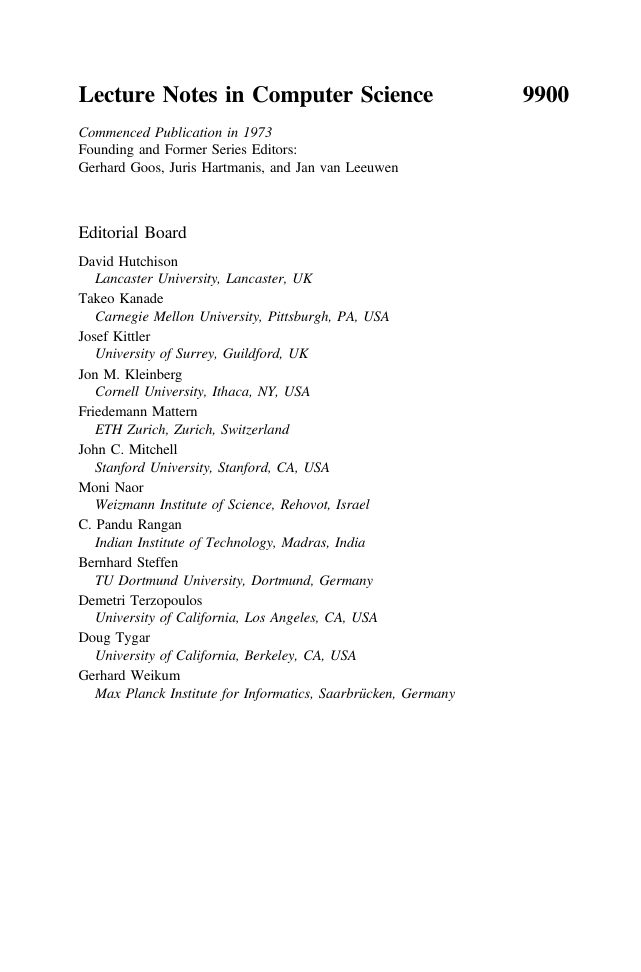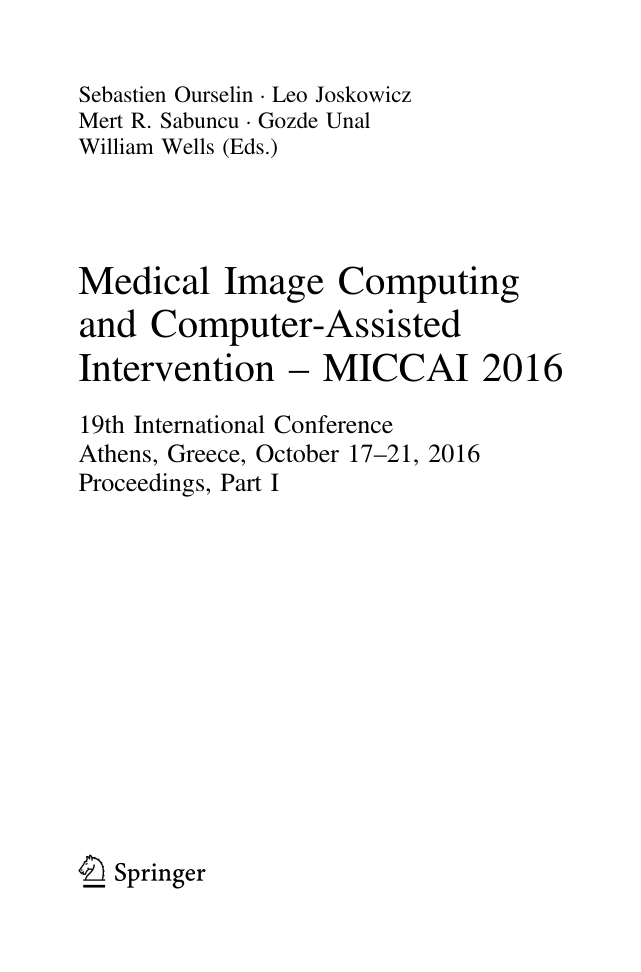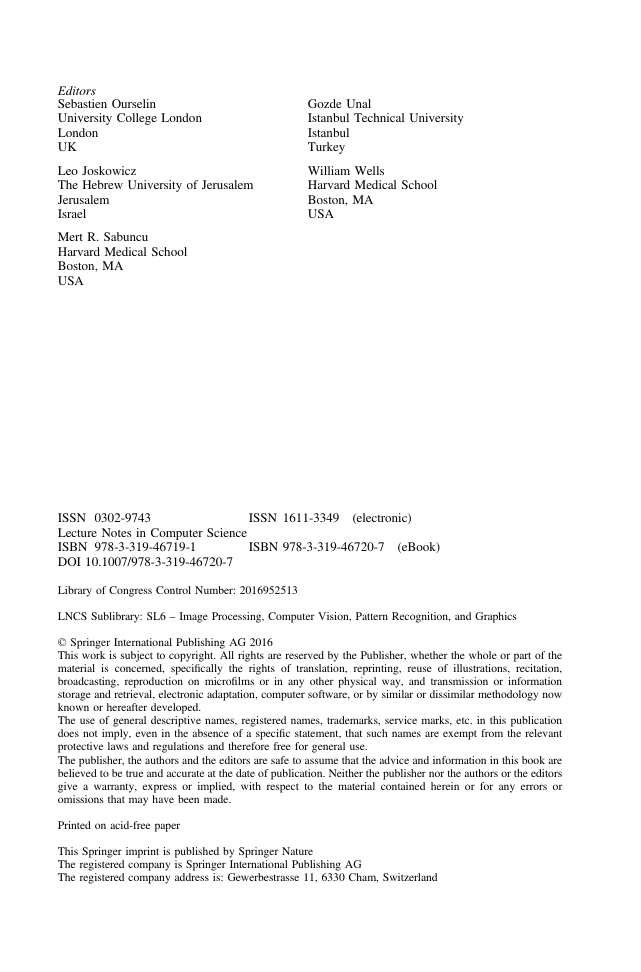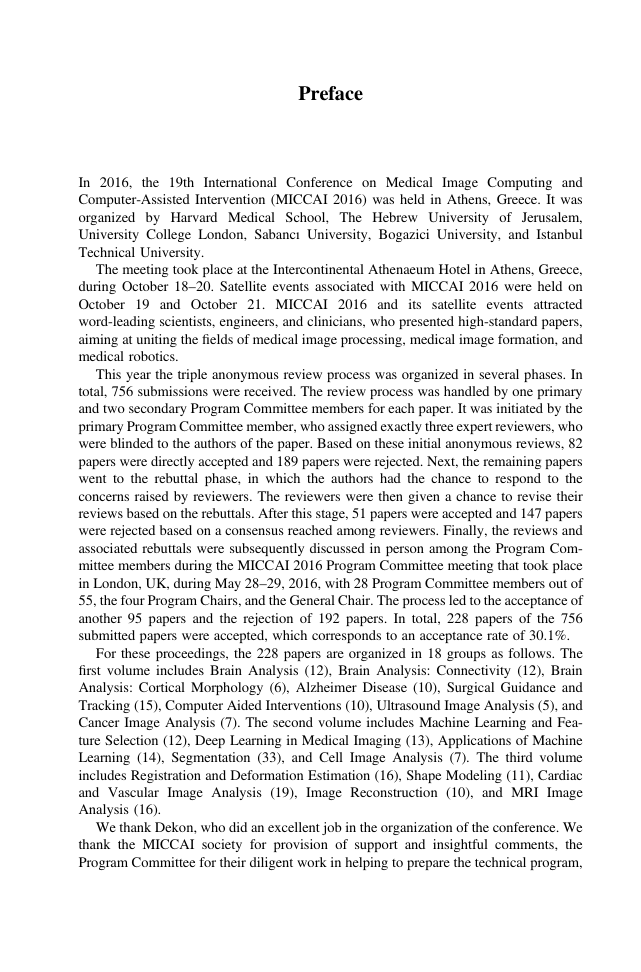Preface
Organization
Contents – Part I
Contents – Part II
Contents – Part III
Ordinal Patterns for Connectivity Networks in Brain Disease Diagnosis
1 Introduction
2 Method
2.1 Data and Preprocessing
2.2 Ordinal Pattern and Frequent Ordinal Pattern
2.3 Ordinal Pattern Based Learning
3 Experiments
4 Conclusion
References
Discovering Cortical Folding Patterns in Neonatal Cortical Surfaces Using Large-Scale Dataset
Abstract
1 Introduction
2 Methods
3 Results
4 Conclusion
Acknowledgements
References
Modeling Functional Dynamics of Cortical Gyri and Sulci
Abstract
1 Introduction
2 Materials and Methods
2.1 Data Acquisition and Pre-processing
2.2 tfMRI Signals’ Temporal Segments Extraction
2.3 SOPFN Identification via Group-Wise Sparse Representation of tfMRI Signal Temporal Segments
2.4 Temporal Dynamics Assessment of SOPFN Distribution on Gyri/Sulci
3 Experimental Results
3.1 Group-Wise Consistent Functional Networks Within Different Time Windows
3.2 Temporal Dynamics Difference of SOPFN Distribution on Gyri/Sulci
4 Discussion and Conclusion
References
A Multi-stage Sparse Coding Framework to Explore the Effects of Prenatal Alcohol Exposure
Abstract
1 Introduction
2 Materials and Methods
2.1 Overview
2.2 Data Acquisition and Pre-processing
2.3 Dictionary Learning and Sparse Representation
2.4 Constrain Spatial Maps in Dictionary Learning
2.5 Constrain Temporal Features in Dictionary Learning
2.6 Statistical Mapping
3 Experimental Results
3.1 Identified Group-Level Activation Maps by Concatenated Sparse Coding
3.2 Learned Individualized Temporal Patterns
3.3 Affected Activation Networks by Prenatal Alcohol Exposure
4 Conclusion
Acknowledgements
References
Correlation-Weighted Sparse Group Representation for Brain Network Construction in MCI Classification
1 Introduction
2 Brain Network Construction and MCI Classification
2.1 Correlation-Weighted Sparse Group Representation for BFCN Construction
2.2 MCI Classification
3 Experiments
3.1 Brain Functional Network Construction
3.2 Classification Results
4 Conclusion
References
Temporal Concatenated Sparse Coding of Resting State fMRI Data Reveal Network Interaction Changes in mTBI
Abstract
1 Introduction
2 Materials and Method
2.1 Overview
2.2 Data Acquisition and Pre-processing
2.3 Concatenated Sparse Coding
2.4 Network Interaction Statistics
3 Results
3.1 Common Networks from Temporal Concatenated Sparse Coding
3.2 Interaction Analysis and Comparison
4 Conclusion
Acknowledgement
References
Exploring Brain Networks via Structured Sparse Representation of fMRI Data
Abstract
1 Introduction
2 Method
2.1 Overview
2.2 Data Acquisition and Preprocessing
2.3 The Whole Brain Signals Dictionary Learning
2.4 Grouping fMRI Signals with Anatomical AAL Template
2.5 Anatomical Guided Structured Multi-task Regression (AGSMR)
3 Results
3.1 Identifying Resting State Networks on Seven Task Datasets
3.2 Comparison Between Our Method and Traditional Method
4 Conclusion
Acknowledgements
References
Discover Mouse Gene Coexpression Landscape Using Dictionary Learning and Sparse Coding
Abstract
1 Introduction
2 Methods
2.1 Experimental Setup
2.2 Dictionary Learning and Sparse Coding
2.3 Enrichment Analysis of GCNs
3 Results
3.1 Validation Against Raw ISH Data
3.2 Enrichment Analysis of GCNs
4 Discussion
References
Integrative Analysis of Cellular Morphometric Context Reveals Clinically Relevant Signatures in Lower Grade Glioma
1 Introduction
2 Approaches
2.1 Construction of Cellular Morphometric Types and Cellular Morphometric Context
2.2 Integrative Analysis
3 Experiments and Discussion
3.1 Phenotypic Visualization and Integrative Analysis of Cellular Morphometric Types
3.2 Subtyping and Integrative Analysis of Cellular Morphometric Context
4 Conclusion and Future Work
References
Mapping Lifetime Brain Volumetry with Covariate-Adjusted Restricted Cubic Spline Regression from Cross-Sectional Multi-site MRI
Abstract
1 Introduction
2 Methods
2.1 Extracting Volumetric Information
2.2 Covariate-Adjusted Restricted Cubic Spline (C-RCS)
2.3 Regressing Out Confound Effects by C-RCS Regression in GLM Fashion
2.4 SCNs and CI Using Bootstrap Method
3 Results
4 Conclusion and Discussion
Acknowledgments
References
Extracting the Core Structural Connectivity Network: Guaranteeing Network Connectedness Through a Graph-Theoretical Approach
1 Introduction
2 Definitions, Problems, and Contributions
3 Experiments and Results
3.1 Consistency of the Extracted Graph
3.2 Predicting Gender-Specific Connectivity
4 Discussion and Conclusion
References
Fiber Orientation Estimation Using Nonlocal and Local Information
1 Introduction
2 Methods
2.1 Background: A Signal Model with Sparsity and Smoothness Regularization
2.2 FO Estimation Incorporating Nonlocal Information
3 Results
3.1 3D Digital Crossing Phantom
3.2 Brain dMRI
4 Conclusion
References
Reveal Consistent Spatial-Temporal Patterns from Dynamic Functional Connectivity for Autism Spectrum Disorder Identification
Abstract
1 Introduction
2 Method
2.1 Construct Robust Functional Connectivity
2.2 Characterize Dynamic Functional Connectivity
2.3 Identifying ASD Subject with the Learned Static/Dynamic FC Patterns
3 Experiment
4 Conclusion
References
Boundary Mapping Through Manifold Learning for Connectivity-Based Cortical Parcellation
1 Introduction
2 Method
3 Experiments
4 Conclusions
References
Species Preserved and Exclusive Structural Connections Revealed by Sparse CCA
Abstract
1 Introduction
2 Materials and Methods
2.1 Data and Preprocessing
2.2 Sparse Canonical Correlation Analysis (SCCA)
3 Results
3.1 Cross-Validation
3.2 DTI Tracts Comparison Between Human and Macaque
4 Conclusion
References
Modularity Reinforcement for Improving Brain Subnetwork Extraction
1 Introduction
2 Methods
2.1 Local Thresholding
2.2 Modularity Reinforcement
2.3 Subnetwork Extraction
3 Materials
3.1 Synthetic Data
3.2 Real Data
4 Results and Discussion
4.1 Synthetic Data
4.2 Real Data
5 Conclusions
References
Effective Brain Connectivity Through a Constrained Autoregressive Model
1 Introduction
2 Method
2.1 Structurally Constrained Autoregressive Model
2.2 Effective Brain Community Detection
3 Data and Experimental Settings
3.1 Pre-processing and Connectome Construction
4 Results and Discussions
5 Conclusions
References
GraMPa: Graph-Based Multi-modal Parcellation of the Cortex Using Fusion Moves
1 Introduction
2 Methods
2.1 Modality Specific Markov Random Field Formulation
2.2 Merging Modalities with Fusion Moves
2.3 Application to Multi-modality Informed rs-fMRI Parcellation
3 Results
4 Discussion
References
A Continuous Model of Cortical Connectivity
1 Introduction
2 Continuous Connectivity Model
2.1 Model Definition
2.2 Recovery of the Intensity Function
2.3 Selecting a Parcellation
3 Application to CoRR Test-Retest Data
3.1 Procedure, Connectome Generation, and Evaluation
3.2 Results and Discussion
4 Conclusion
References
Label-Informed Non-negative Matrix Factorization with Manifold Regularization for Discriminative Subnetwork Detection
Abstract
1 Introduction
2 Method
3 Experiments and Conclusions
3.1 Experimental Results and Conclusions
References
Predictive Subnetwork Extraction with Structural Priors for Infant Connectomes
1 Introduction
2 Method
2.1 Preterm Data
2.2 Subnetwork Extraction
2.3 Network Backbone Prior
2.4 Connectivity Prior
3 Results
4 Conclusions
References
Hierarchical Clustering of Tractography Streamlines Based on Anatomical Similarity
1 Introduction
2 Methods
2.1 Normalized Cuts
2.2 Similarity Measures
3 Results
3.1 Data Analysis
3.2 Comparison with Manual Labeling
3.3 Anatomical and Spatial Consistency of Clusters
4 Conclusion
References
Unsupervised Identification of Clinically Relevant Clusters in Routine Imaging Data
1 Introduction
2 Identification of Clusters
3 Evaluation
4 Results
5 Conclusion
References
Probabilistic Tractography for Topographically Organized Connectomes
1 Introduction
2 Methods
3 Test Subjects and Experimental Setup
4 Results
5 Discussions and Conclusion
References
A Hybrid Multishape Learning Framework for Longitudinal Prediction of Cortical Surfaces and Fiber Tracts Using Neonatal Data
1 Introduction
2 Hybrid Longitudinal Surface-Fiber Evolution Modeling (Training Stage)
3 Longitudinal Multishape Prediction Algorithm from Baseline (Testing Stage)
4 Experiments and Discussion
5 Conclusion
References
Learning-Based Topological Correction for Infant Cortical Surfaces
Abstract
1 Introduction
2 Method
2.1 Extracting Candidate Voxels
2.2 Inferring New Labels of Candidate Voxels Using Anatomical References
2.3 Iterative Framework
3 Experiments
4 Conclusion
Acknowledgements
References
Riemannian Metric Optimization for Connectivity-Driven Surface Mapping
1 Introduction
2 Riemannian Metric Optimization on Surfaces (RMOS)
3 Results
4 Conclusion
References
Riemannian Statistical Analysis of Cortical Geometry with Robustness to Partial Homology and Misalignment
1 Introduction and Related Work
2 Methods
2.1 Modeling the Cortex
2.2 Multivariate Local Descriptor of Cortical Folding and Thickness
2.3 Riemannian Statistical Modeling
2.4 Permutation Testing for Riemannian Statistical Analysis
3 Results and Conclusion
References
Modeling Fetal Cortical Expansion Using Graph-Regularized Gompertz Models
1 Introduction
2 Regularizing Parametric Cortical Growth Models
3 Data, Cortical Segmentation, and Tracking
4 Results
5 Conclusion
References
Longitudinal Analysis of the Preterm Cortex Using Multi-modal Spectral Matching
1 Introduction
2 Data and Image Processing
3 Pairing Images Using Multi-Modal Spectra (PIMMS)
4 Groupwise Analysis of Longitudinal Changes
5 Discussion
References
Early Diagnosis of Alzheimer’s Disease by Joint Feature Selection and Classification on Temporally Structured Support Vector Machine
Abstract
1 Introduction
2 Methods
2.1 Temporally Structured SVM for Early Detection of AD
2.2 Joint Feature Selection and Classification on TS-SVM
2.3 Optimization
3 Experiments
4 Conclusion
References
Prediction of Memory Impairment with MRI Data: A Longitudinal Study of Alzheimer's Disease
1 Introduction
2 Longitudinal Structured Low-Rank Regression Model
3 Optimization Algorithm for Solving Problem(1)
4 Experimental Results
4.1 Data Description
4.2 Performance Comparison on the ADNI Cohort
4.3 Identification of Longitudinal Imaging Markers
5 Conclusion
References
Joint Data Harmonization and Group Cardinality Constrained Classification
1 Introduction
2 Jointly Learning of Harmonization and Classification
2.1 Sequential Harmonization and Classification
2.2 Simultaneous Harmonization and Classification
3 Distinguishing HAND from MCI
4 Conclusion
References
Progressive Graph-Based Transductive Learning for Multi-modal Classification of Brain Disorder Disease
Abstract
1 Introduction
2 Methods
2.1 Progressive Graph-Based Transductive Learning
2.2 Optimization
3 Experiments
4 Conclusion
References
Structured Outlier Detection in Neuroimaging Studies with Minimal Convex Polytopes
1 Introduction
2 Method
2.1 Model Selection
3 Experimental Validation
3.1 Simulated Data
3.2 Application to a Study of Alzheimer's Disease
4 Conclusion
References
Diagnosis of Alzheimer's Disease Using View-Aligned Hypergraph Learning with Incomplete Multi-modality Data
1 Introduction
2 Method
3 Experiments
4 Conclusion
References
New Multi-task Learning Model to Predict Alzheimer's Disease Cognitive Assessment
1 Introduction
2 New Multi-task Learning Model
2.1 New Objective Function
2.2 Optimization Algorithm
2.3 Algorithm Analysis
3 Experimental Results and Discussions
3.1 Data Set Description
3.2 Improved Cognitive Status Prediction for Individual Assessment Tests
3.3 Improved Cognitive Performance Prediction for Joint Assessment Tests
4 Conclusion
References
Hyperbolic Space Sparse Coding with Its Application on Prediction of Alzheimer's Disease in Mild Cognitive Impairment
1 Introduction
2 Hyperbolic Space Sparse Coding
2.1 Hyperbolic Space and Surface Tenser-Based Morphometry
2.2 Ring-Shaped Patch Selection
2.3 Sparse Coding and Dictionary Learning
3 Dataset of Experiments and Classification Results
References
Large-Scale Collaborative Imaging Genetics Studies of Risk Genetic Factors for Alzheimer's Disease Across Multiple Institutions
1 Introduction
2 Data Processing
2.1 ADNI GWAS Data
2.2 Data Partition
3 Methods
3.1 Local Query Model
3.2 Safe Screening Rules for Lasso
3.3 Distributed Safe Screening Rules for Lasso
3.4 Local Query Model for Lasso
4 Experiment
4.1 Comparison of Lasso with and Without D-EDPP Rule
4.2 Stability Selection for Top Risk Genetic Factors
References
Structured Sparse Low-Rank Regression Model for Brain-Wide and Genome-Wide Associations
1 Introduction
2 Methodology
2.1 Notations
2.2 Low-Rank Multi-output Linear Regression
2.3 Structured Sparse Low-Rank Multi-output Linear Regression
3 Experimental Analysis
3.1 Preprocessing and Feature Extraction
3.2 Experimental Setting
3.3 Experimental Results
4 Conclusion
References
3D Ultrasonic Needle Tracking with a 1.5D Transducer Array for Guidance of Fetal Interventions
1 Introduction
2 Materials and Methods
2.1 System Configuration
2.2 Tracking Algorithms
2.3 Relative Tracking Accuracy
2.4 In Vivo Validation
2.5 SNR Analysis
3 Results and Discussion
References
Enhancement of Needle Tip and Shaft from 2D Ultrasound Using Signal Transmission Maps
1 Introduction
2 Methods
2.1 L1-Norm Based Contextual Regularization for Image Enhancement
2.2 Data Acquisition and Analysis
3 Experimental Results
4 Discussions and Conclusions
References
Plane Assist: The Influence of Haptics on Ultrasound-Based Needle Guidance
1 Introduction
2 Vision-Based Guidance System and Haptic Feedback
2.1 Visual Guidance
2.2 Haptic Guidance
3 Experimental Methods
3.1 Experiment Set-Up
3.2 Guidance Conditions
4 Results
5 Conclusion
References
A Surgical Guidance System for Big-Bubble Deep Anterior Lamellar Keratoplasty
1 Introduction
2 Method
2.1 OCT Acquisition
2.2 Visualization
2.3 Tracking
2.4 Augmented Reality
3 Experiments and Results
4 Conclusion
References
Real-Time 3D Tracking of Articulated Tools for Robotic Surgery
1 Introduction
2 Methods
2.1 Part-Based Online Templates for Tool Detection
2.2 Tool Part Verification via 2D Geometrical Context
2.3 From 2D to 3D Tool Pose Estimation
3 Results
4 Conclusions
References
Towards Automated Ultrasound Transesophageal Echocardiography and X-Ray Fluoroscopy Fusion Using an Image-Based Co-registration Method
1 Introduction
2 Methods
2.1 In-Plane Pose Tracking
2.2 Out-of-Plane Pose Tracking
2.3 Tracking Initialization and Failure Detection
2.4 3D-2D Registration Based Pose Refinement
3 Experiment Setup, Results and Discussions
4 Conclusion
References
Robust, Real-Time, Dense and Deformable 3D Organ Tracking in Laparoscopic Videos
1 Introduction and Background
2 Methodology
3 Experimental Results
4 Conclusion
References
Structure-Aware Rank-1 Tensor Approximation for Curvilinear Structure Tracking Using Learned Hierarchical Features
1 Introduction
2 Candidate Detection with Hierarchical Features
3 Tracking with Model Prior
4 Experiments
5 Conclusion
References
Real-Time Online Adaption for Robust Instrument Tracking and Pose Estimation
1 Introduction and Related Work
2 Method
2.1 Tracker -- Offline Learning, Online Adaption
2.2 2D Pose Estimation with Temporal-Spatial Constraints
2.3 Closed Loop via Integrator
3 Experiments and Results
3.1 Evaluation of Components
3.2 Comparison to State-of-the-Art
4 Conclusion
References
Integrated Dynamic Shape Tracking and RF Speckle Tracking for Cardiac Motion Analysis
1 Introduction
2 Methods
2.1 Dynamic Shape Tracking (DST)
2.2 Speckle Tracking
2.3 Integrated Dense Displacement Field
3 Experiment and Results
4 Conclusion
References
The Endoscopogram: A 3D Model Reconstructed from Endoscopic Video Frames
1 Introduction
2 Endoscopogram Reconstruction Pipeline
3 Geometry Fusion
3.1 N-Body Surface Registration
3.2 Outlier Geometry Trimming
4 Results
5 Conclusion
References
Robust Image Descriptors for Real-Time Inter-Examination Retargeting in Gastrointestinal Endoscopy
1 Introduction
2 Methods
2.1 A Global Image Descriptor for Endoscopic Scenes
2.2 Compressing the Descriptor into a Compact Binary Code
2.3 Learning Encoding Functions with Random Forests
3 Experiments and Results
4 Conclusions
References
Kalman Filter Based Data Fusion for Needle Deflection Estimation Using Optical-EM Sensor
Abstract
1 Introduction
2 Methodology
2.1 Sensor Fusion
2.2 Bending Model
3 Experiments
4 Discussion
5 Conclusion
References
Bone Enhancement in Ultrasound Based on 3D Local Spectrum Variation for Percutaneous Scaphoid Fracture Fixation
1 Introduction
2 Methods
2.1 Phase Symmetry Estimation
2.2 Enhancement of Bone Responses in US
2.3 Registration of a Statistical Wrist Model
3 Experiments, Evaluation and Results
3.1 Experimental Setup
3.2 Evaluation
3.3 Results
4 Discussion and Conclusion
References
Bioelectric Navigation: A New Paradigm for Intravascular Device Guidance
1 Introduction
2 Materials and Methods
2.1 Modeling Bioimpedance as a Function of Catheter Location
2.2 Cross-Sectional Area to Parameterize Vessel Tree
2.3 Bioimpedance Acquisition
2.4 Modeled and Empirical Signal Matching
3 Experiments and Results
3.1 Experimental Setup
3.2 Synthetic Vessel Tree
3.3 Ex Vivo Aorta
4 Discussion
5 Scientific and Clinical Context
References
Process Monitoring in the Intensive Care Unit: Assessing Patient Mobility Through Activity Analysis with a Non-Invasive Mobility Sensor
1 Introduction
1.1 Related Work
2 Methods
2.1 Multi-person Tracking by Fusing Multiple Detectors
2.2 Activity Analysis by Contextual Attributes
3 Experiments and Discussions
4 Conclusions
References
Patient MoCap: Human Pose Estimation Under Blanket Occlusion for Hospital Monitoring Applications
1 Introduction
2 Related Work
3 Methods
3.1 Convolutional Neural Network
3.2 Recurrent Neural Network
3.3 Patient MoCap Dataset
3.4 Blanket Simulation
4 Experiments
4.1 Comparison on the Patient MoCap Dataset
4.2 Blanket Occlusion
5 Conclusions
References
Numerical Simulation of Cochlear-Implant Surgery: Towards Patient-Specific Planning
1 Introduction
2 Numerical Models and Algorithms
3 Experimental Validation
4 Sensitivity of the Results to Mechanical and Clinical Parameters
5 Conclusion and Future Work
References
Meaningful Assessment of Surgical Expertise: Semantic Labeling with Data and Crowds
1 Introduction
2 Semantic Descriptors of Expertise
3 Experimental Setup and Methods
3.1 Data Collection System
3.2 Simulated Surgical Tasks and Human Subject Study
3.3 Crowd-Worker Recruitment and Tasks
3.4 Data Analysis Methods
4 Results and Discussion
5 Conclusions and Future Work
References
2D-3D Registration Accuracy Estimation for Optimised Planning of Image-Guided Pancreatobiliary Interventions
Abstract
1 Introduction
2 Analytical Estimation of 2D-3D Registration Error
3 Estimation of Planning Error for ERCP-Guided Procedures
4 Experiment and Results
5 Conclusion and Discussion
Acknowledgements
References
Registration-Free Simultaneous Catheter and Environment Modelling
1 Introduction
2 Methods
3 Results
3.1 Monte-Carlo Simulation
3.2 Phantom Experiments
3.3 In-vivo Experiments
4 Conclusion
References
Pareto Front vs. Weighted Sum for Automatic Trajectory Planning of Deep Brain Stimulation
1 Introduction
2 Materials and Methods
2.1 Method 1: Pareto Front (MPF)
2.2 Method 2: Weighted Sum Exploration (MWSE)
2.3 Discretization of the Solution Space
2.4 Evaluation Study
3 Results and Discussion
4 Conclusion
References
Efficient Anatomy Driven Automated Multiple Trajectory Planning for Intracranial Electrode Implantation
1 Introduction
2 Methodology
2.1 Regions of Interest and Critical Structure Extraction
2.2 Candidate Target Point Selection
2.3 Automated Trajectory Planning
3 Experimental Design and Results
3.1 Experimental Design
3.2 Trajectory Suitability
3.3 Implantation Plan Suitability
3.4 Computational Efficiency
4 Concluding Remarks
References
Recognizing Surgical Activities with Recurrent Neural Networks
1 Introduction
2 Methods
2.1 Recurrent Neural Networks
2.2 Long Short-Term Memory
3 Experiments
3.1 Datasets
3.2 Experimental Setup
3.3 Hyperparameter Selection and Training
3.4 Results
4 Summary
References
Two-Stage Simulation Method to Improve Facial Soft Tissue Prediction Accuracy for Orthognathic Surgery
Abstract
1 Introduction
2 Two-Stage FEM Simulation Algorithm
2.1 The First Stage of FEM Simulation with Simple Sliding Effect
2.2 The Second Stage of FEM Simulation with Advanced Sliding Effect
3 Quantitative and Qualitative Evaluations and Results
4 Discussion and Future Work
References
Hand-Held Sound-Speed Imaging Based on Ultrasound Reflector Delineation
1 Introduction
2 Methods
2.1 Reflector Delineation
2.2 Total-Variation Sound-Speed Image Reconstruction
2.3 Tissue Phantoms, Ex-vivo and In-vivo Tests
3 Results and Discussion
4 Conclusions and Outlook
References
Ultrasound Tomosynthesis: A New Paradigm for Quantitative Imaging of the Prostate
Abstract
1 Introduction
2 Method
2.1 System Components
2.2 Data Processing
2.3 Simulation Setup
2.4 Phantom Study
3 Results
3.1 Simulation Results
3.2 Phantom Results
4 Conclusions
Acknowledgement
References
Photoacoustic Imaging Paradigm Shift: Towards Using Vendor-Independent Ultrasound Scanners
Abstract
1 Introduction
2 Methods
2.1 Approach I: Inverse Beamforming
2.2 Approach II: Synthetic Aperture Based Re-Beamforming
2.3 Simulation and Experiment Setup
3 Results
3.1 Simulation Analysis
3.2 Validation Using Pseudo-Photoacoustic Signal Source
3.3 In Vivo Prostate Cancer Visualization
4 Discussion and Conclusion
Acknowledgement
References
4D Reconstruction of Fetal Heart Ultrasound Images in Presence of Fetal Motion
1 Introduction
2 Material
3 Method
3.1 Mean Heart Rate (HR) Estimation
3.2 4D Reconstruction
4 Experiments and Results
4.1 Mean Heart Rate (HR) Estimation
4.2 4D Reconstruction of Simulated Data
4.3 4D Reconstruction of In-Vivo Data
5 Discussion and Conclusion
References
Towards Reliable Automatic Characterization of Neonatal Hip Dysplasia from 3D Ultrasound Images
1 Introduction
2 Methods
2.1 Extraction of Bone/Cartilage Structures
2.2 Localization of the 3D Ilium and Acetabulum Surfaces
2.3 Computation of the 3D Angle
3 Results and Discussion
4 Conclusions
References
Image-Based Computer-Aided Diagnostic System for Early Diagnosis of Prostate Cancer
1 Introduction
2 Methods
2.1 Feature Extraction
2.2 A Two-Stage Classification
3 Experimental Results
4 Conclusions
References
Multidimensional Texture Analysis for Improved Prediction of Ultrasound Liver Tumor Response to Chemotherapy Treatment
1 Introduction
2 Materials and Methods
2.1 Ultrasound RF Data Analysis
2.2 Circular Harmonic Wavelets
2.3 Heterogeneity Quantification
3 Results and Discussion
3.1 Clinical Tumor Cross-Sectional Dataset
3.2 Statistical Analysis
4 Conclusion
References
Classification of Prostate Cancer Grades and T-Stages Based on Tissue Elasticity Using Medical Image Analysis
1 Introduction
2 Method
2.1 Forward Simulation: BioTissue Modeling
2.2 Inverse Process: Optimization for Parameter Identification
2.3 Classification Methods
3 Patient Data Study
3.1 Preprocessing and Patient Dataset
3.2 Cancer Grading/Staging Classification Based on Prostate Elasticity Parameters
4 Conclusion and Future Work
References
Automatic Determination of Hormone Receptor Status in Breast Cancer Using Thermography
1 Introduction
2 Effect of Hormone Receptor Status on Thermography
3 Automatic Feature Extraction for Hormone Receptor Status
3.1 Abnormal Region Extraction
3.2 Entire ROI Features
4 Dataset Description
5 Classification Results
6 Conclusions and Future Work
References
Prostate Cancer: Improved Tissue Characterization by Temporal Modeling of Radio-Frequency Ultrasound Echo Data
1 Introduction
2 RF Time Series Data
3 Probabilistic Modeling Using Hidden Markov Models
4 Results and Discussion
5 Conclusion
References
Classifying Cancer Grades Using Temporal Ultrasound for Transrectal Prostate Biopsy
1 Introduction
2 Materials and Methods
2.1 Data
2.2 Preprocessing
2.3 Cancer Grading
3 Results and Discussion
4 Conclusion
References
Characterization of Lung Nodule Malignancy Using Hybrid Shape and Appearance Features
1 Introduction
2 Methods
2.1 Spherical Harmonics Computation
2.2 DCNN Appearance Feature Extraction:
2.3 RF Classification
3 Experiments and Results
4 Discussion and Conclusion
References
Author Index
















 2023年江西萍乡中考道德与法治真题及答案.doc
2023年江西萍乡中考道德与法治真题及答案.doc 2012年重庆南川中考生物真题及答案.doc
2012年重庆南川中考生物真题及答案.doc 2013年江西师范大学地理学综合及文艺理论基础考研真题.doc
2013年江西师范大学地理学综合及文艺理论基础考研真题.doc 2020年四川甘孜小升初语文真题及答案I卷.doc
2020年四川甘孜小升初语文真题及答案I卷.doc 2020年注册岩土工程师专业基础考试真题及答案.doc
2020年注册岩土工程师专业基础考试真题及答案.doc 2023-2024学年福建省厦门市九年级上学期数学月考试题及答案.doc
2023-2024学年福建省厦门市九年级上学期数学月考试题及答案.doc 2021-2022学年辽宁省沈阳市大东区九年级上学期语文期末试题及答案.doc
2021-2022学年辽宁省沈阳市大东区九年级上学期语文期末试题及答案.doc 2022-2023学年北京东城区初三第一学期物理期末试卷及答案.doc
2022-2023学年北京东城区初三第一学期物理期末试卷及答案.doc 2018上半年江西教师资格初中地理学科知识与教学能力真题及答案.doc
2018上半年江西教师资格初中地理学科知识与教学能力真题及答案.doc 2012年河北国家公务员申论考试真题及答案-省级.doc
2012年河北国家公务员申论考试真题及答案-省级.doc 2020-2021学年江苏省扬州市江都区邵樊片九年级上学期数学第一次质量检测试题及答案.doc
2020-2021学年江苏省扬州市江都区邵樊片九年级上学期数学第一次质量检测试题及答案.doc 2022下半年黑龙江教师资格证中学综合素质真题及答案.doc
2022下半年黑龙江教师资格证中学综合素质真题及答案.doc